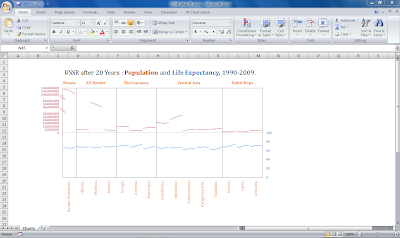Delighted to be back after three weeks of treatment, care and medication. I rarely fall ill, so this afforded a nice break from my regular activities and also the chance to browse several websites which deal with data analysis and presentation.
My data-set for this week is from the Guardian Datablog, dated Aug 17th, titled "End of the USSR". The piece is accompanied by an image that uses a map to rate the former soviet provinces on their performance since the collapse.
The data includes yearly figures of GDP, GDP per Capita, Population, Life expectancy and Mortality among other interesting indicators like Intentional homicides, Prison population rate, Prevalence of HIV by gender, Unemployment, Happiness index score, Global peace index and Number of McDonald's!
Given the large difference in figures between Russia and other republics, I was curious to see how the presenter would design the population and the GDP charts for comparison.
I was massively disappointed. The population chart is simply a column chart representing the percentage change of population in 2009 from 1991, and a label to display the current population - very much an easy way out. The GDP chart can be found nowhere, although there is a clustered column chart that displays the GDP per Capita for 3 years out of 20. 1991, 2000 and 2009.
I spent an idle afternoon working on the Population and Life expectancy data and came up with the following after 2 hours.

Comments
Post a Comment
Please do not post spam or promote your own site(s). Comments are moderated and such comments will not be published.
Also, please keep your comment relevant to the topic of the article.
Finally, please do not post any of your personally identifiable information such as phone number, email address or other important details as this is an open platform.